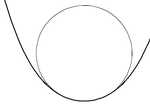Contact (mathematics)
In mathematics, two functions have a contact of order k if they have the same value at a point P and also the same derivatives there, up to order k. This is an equivalence relation, whose equivalence classes are generally called jets. The point of osculation is also called the double cusp.
One speaks also of curves and geometric objects having k-th order contact at a point: this is also called osculation (i.e. kissing), generalising the property of being tangent. An osculating curve from a given family of curves is a curve that has the highest possible order of contact with a given curve at a given point; for instance a tangent line is an osculating curve from the family of lines, and has first-order contact with the given curve; an osculating circle is an osculating curve from the family of circles, and has second-order contact, etc.[1]
Contact forms are particular differential forms of degree 1 on odd-dimensional manifolds; see contact geometry. Contact transformations are related changes of co-ordinates, of importance in classical mechanics. See also Legendre transformation.
Contact between manifolds is often studied in singularity theory, where the type of contact are classified, these include the A series (A0: crossing, A1: tangent, A2: osculating, ...) and the umbilic or D-series where there is a high degree of contact with the sphere.
Contact between curves
Two curves in the plane intersecting at a point p are said to have:
- 1-point contact if the curves have a simple crossing (not tangent).
- 2-point contact if the two curves are tangent.
- 3-point contact if the curvatures of the curves are equal. Such curves are said to be osculating.
- 4-point contact if the derivatives of the curvature are equal.
- 5-point contact if the second derivatives of the curvature are equal.
Contact between a curve and a circle



For a smooth curve S in the plane then for each point, S(t) on the curve then there is always exactly one osculating circle which has radius 1/κ(t) where κ(t) is the curvature of the curve at t. If the curve has zero curvature (i.e. an inflection point on the curve) then the osculating circle will be a straight line. The set of the centers of all the osculating circles form the evolute of the curve.
If the derivative of curvature κ'(t) is zero, then the osculating circle will have 4-point contact and the curve is said to have a vertex. The evolute will have a cusp at the center of the circle. The sign of the second derivative of curvature determines whether the curve has a local minimum or maximum of curvature. All closed curves will have at least four vertices, two minima and two maxima (the four-vertex theorem).
In general a curve will not have 5-point with any circle. However, 5-point contact can occur generically[disambiguation needed] in a 1-parameter family of curves, where two vertices (one maximum and one minimum) come together and annihilate. At such points the second derivative of curvature will be zero.
Bi-tangents
It is also possible to consider circles which have two point contact with two points S(t1), S(t2) on the curve. Such circles are bi-tangent circles. The centers of all bi-tangent circles form the symmetry set. The medial axis is a sub set of the symmetry set. These sets have been used as a method of characterising the shapes of biological objects.
References
- ^ Rutter, J. W. (2000), Geometry of Curves, CRC Press, pp. 174–175, ISBN 9781584881667.
- Bruce, J. W. (1992). Curves and Singularities. Cambridge. ISBN 0-521-42999-4.
{{cite book}}: Unknown parameter|coauthors=ignored (|author=suggested) (help) - Ian R. Porteous (2001) Geometric Differentiation, pp 152–7, Cambridge University Press ISBN 0-521-00264-8 .
